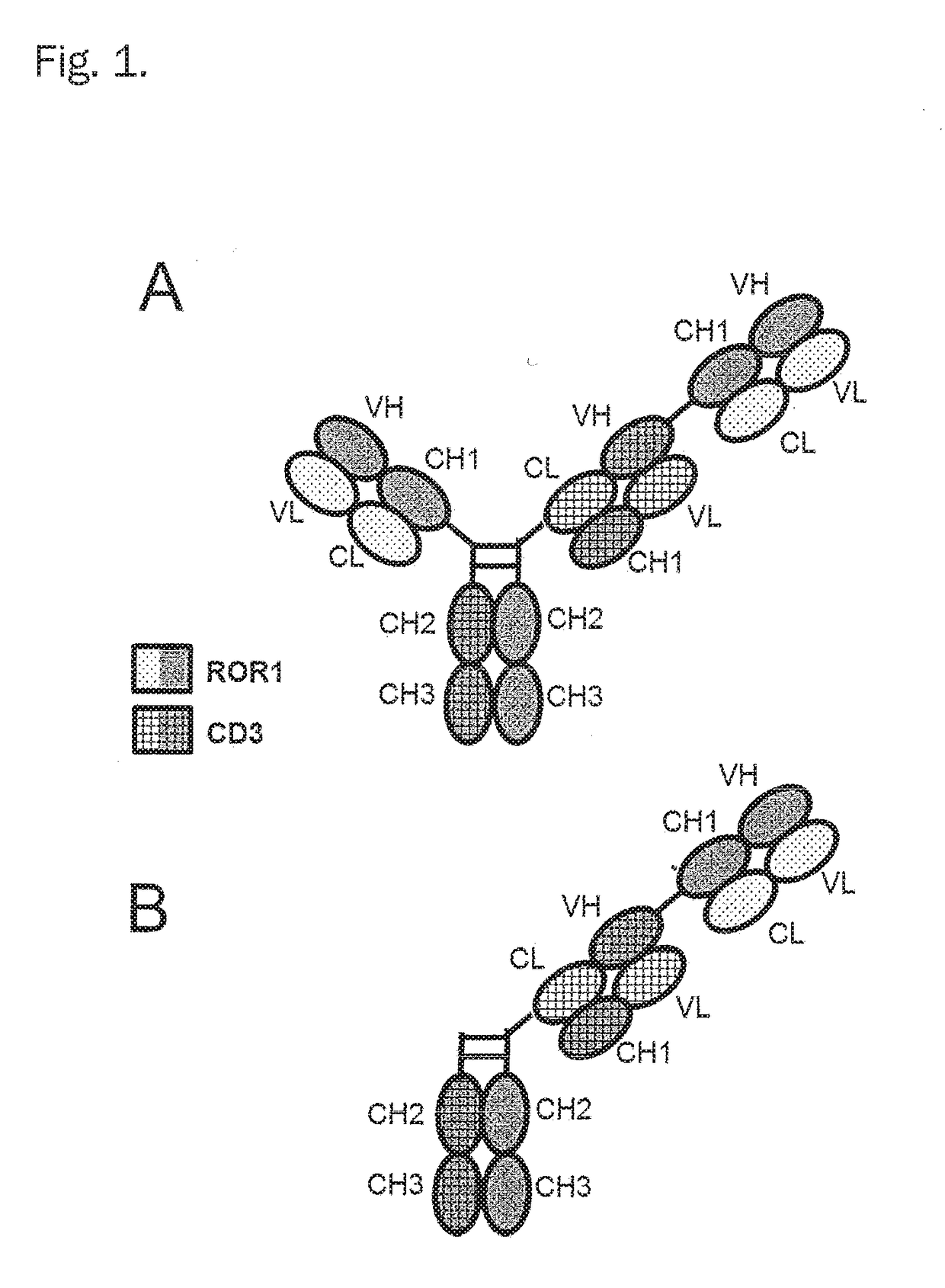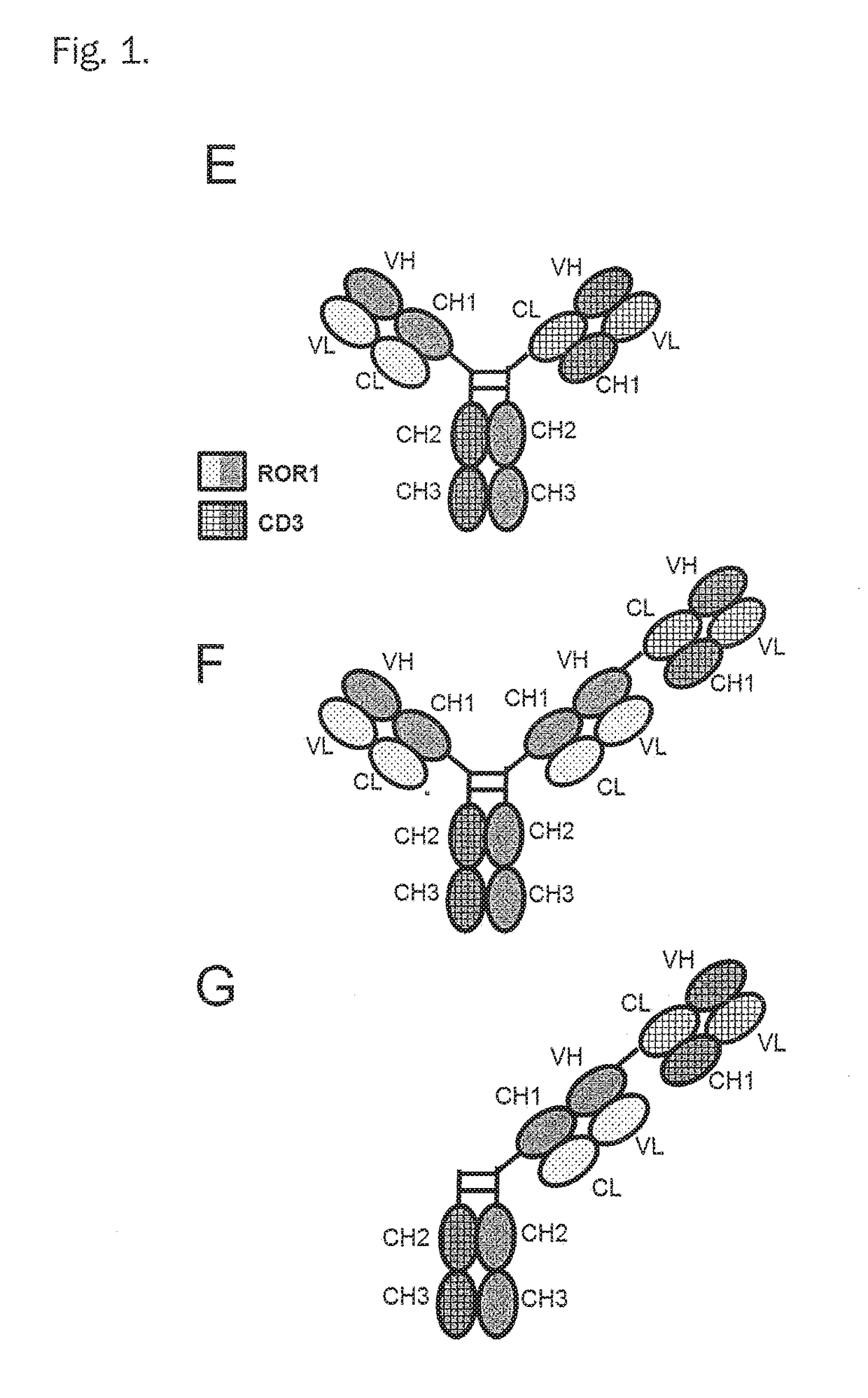Bispecific antibodies against cd3epsilon and ror1 for use in the treatment of ovarian cancer
a technology of ovarian cancer and specific antibodies, which is applied in the direction of transferases, drug compositions, peptides, etc., can solve the problems of modest progress in improving the overall survival of patients with ovarian cancer, inability to respond durablely, and poor prognosis of ovarian cancer, so as to improve the cytotoxicity activity of antibodies and reduce the magnitude of clinical dose range
- Summary
- Abstract
- Description
- Claims
- Application Information
AI Technical Summary
Benefits of technology
Problems solved by technology
Method used
Image
Examples
example 1
Generation of Anti-ROR1 Antibodies
[0263]The protein sequences of the VH and VL regions for an ROR.1 antibody of SEQ ID NOs: 2-9 (MAB I) are described in WO2012 / 075158. Briefly, oliogonucleotides encoding the above sequences are joined together via PCR to synthesize cDNAs encoding the VH are VL sequences, respectively, of the anti-ROR1 antibody.
[0264]For the generation of anti-ROR1 antibody expression vectors, the variable regions of heavy and light chain DNA sequences were subcloned in frame with either the human IgG1 constant heavy chain or the hum IgG1 constant light chain pre-inserted into the respective generic recipient expression vector optimized for expression in mammalian cell lines. The antibody expression was driven by a chimeric MPSV promoter comprising a CMV enhancer and a MPSV promoter followed by a 5′ UTR, an intron and a Ig kappa MAR element. The transcription was terminated by a synthetic polyA signal sequence at the 3′ end of the CDS. All vectors carry a 5′-end DNA ...
example 2
Human Ovarian Cancer Cell Lines with Different Levels of Expression of ROR1 on the Cell Surface
[0266]1) Human ovarian cancer cell line PA-1 derived from ovarian teratocarcinoma is acquired from American Type Culture Collection (ATCC; Cat. No. CRL-1572). PA-1 cell lines are cultured in Eagle's Minimum Essential Medium (MEM) (ATCC, Cat. No. 30-2003) supplemented with 10% fetal bovine serum (heat-inactivated), 2 mM L-glutamne, 1 mM sodium pyruvate, and 1500 mg / L sodium bicarbonate.
[0267]2) Human ovarian cancer cell line MCAS derived from mucinous cystadenocarcinoma of the ovary is obtained from the Japanese Collection of Research Bioresources (JCRB; Cat. No, JCRB0240). MCAS cell lines are grown in Eagle's MEM with 20% FBS.
[0268]3) Human ovarian cancer cell line EFO-21 derived from ovary cystadenocarcinoma is obtained from Leibniz Institute DSMZ- German Collection of Microorganisms and Cell Cultures (DSMZ; Cat. No. ACC 235). EFO-21 cell lines are cultured in 80% :RPM 1640, 20% heat inac...
example 3
Binding of ROR1 IgG Antibodies to ROR1 -Positive Human Ovarian Cancer Cell Lines (as Detected by Flow Cytometry)
[0302]a) The level of expression of ROR1 is measured on human ovarian cancer cell lines by flow cytometry including PA-1, MCAS, EFO-21, COLO-704, SW-626, KURAMOCHI, OVSAHO, SNU-119, COV362, OVCAR-4, COV318, TYK-nu, ON / KATE, CAOV-4, OAW28, CAOV-3, 59M, ONCO-DG-1, OVCAR-3. OVCAR-5, ES-2, COV-504, OV-90, RMUG-S, COV-644, SNU-840, OVISE, OAW42, OVTOKO, OVMANA, COV-434, OV56, SK-OV-3N2780, IGROV-1, and / or TOV-21G. Briefly, cells are harvested, washed, counted for viability, resuspended at 50,000 cells / well of a 96-well round bottom plate and incubated with Alexa488-labeled anti human ROR1 antibody for 30 min at 4° C. All ROR1 and isotype control antibodies are titrated and analyzed in final concentration range between 0.01-100 nM. For samples using non-labelled antibodies, cells are centrifuged (5 min, 350×g), washed with 120 μl / well FACS Stain Buffer (BD Biosciences), resuspen...
PUM
| Property | Measurement | Unit |
|---|---|---|
| molecular weight | aaaaa | aaaaa |
| molecular weight | aaaaa | aaaaa |
| dissociation constant | aaaaa | aaaaa |
Abstract
Description
Claims
Application Information
 Login to View More
Login to View More - R&D
- Intellectual Property
- Life Sciences
- Materials
- Tech Scout
- Unparalleled Data Quality
- Higher Quality Content
- 60% Fewer Hallucinations
Browse by: Latest US Patents, China's latest patents, Technical Efficacy Thesaurus, Application Domain, Technology Topic, Popular Technical Reports.
© 2025 PatSnap. All rights reserved.Legal|Privacy policy|Modern Slavery Act Transparency Statement|Sitemap|About US| Contact US: help@patsnap.com



